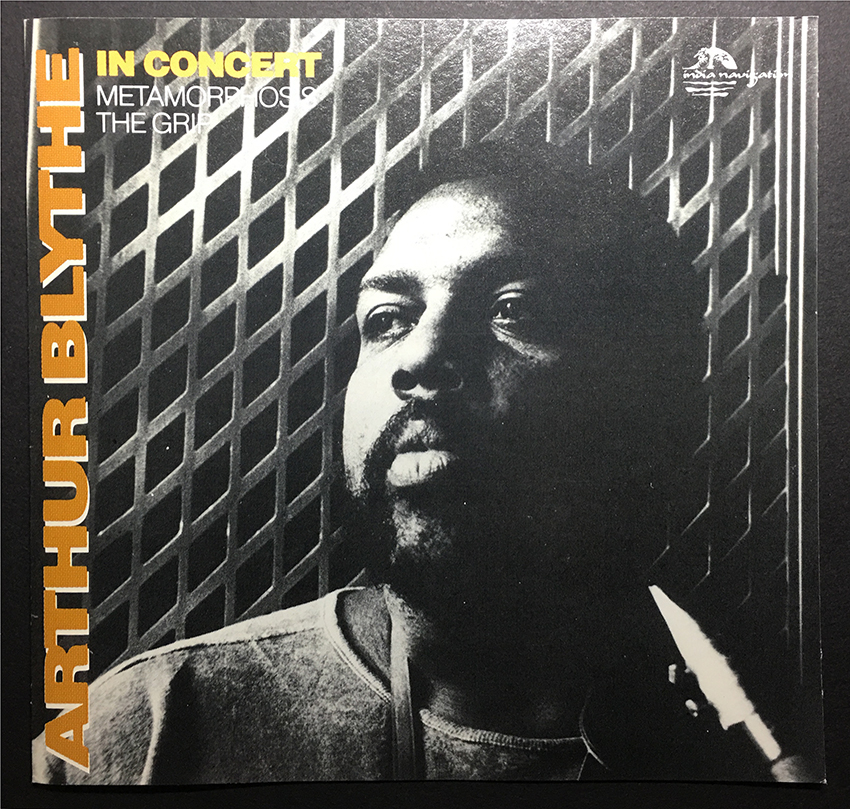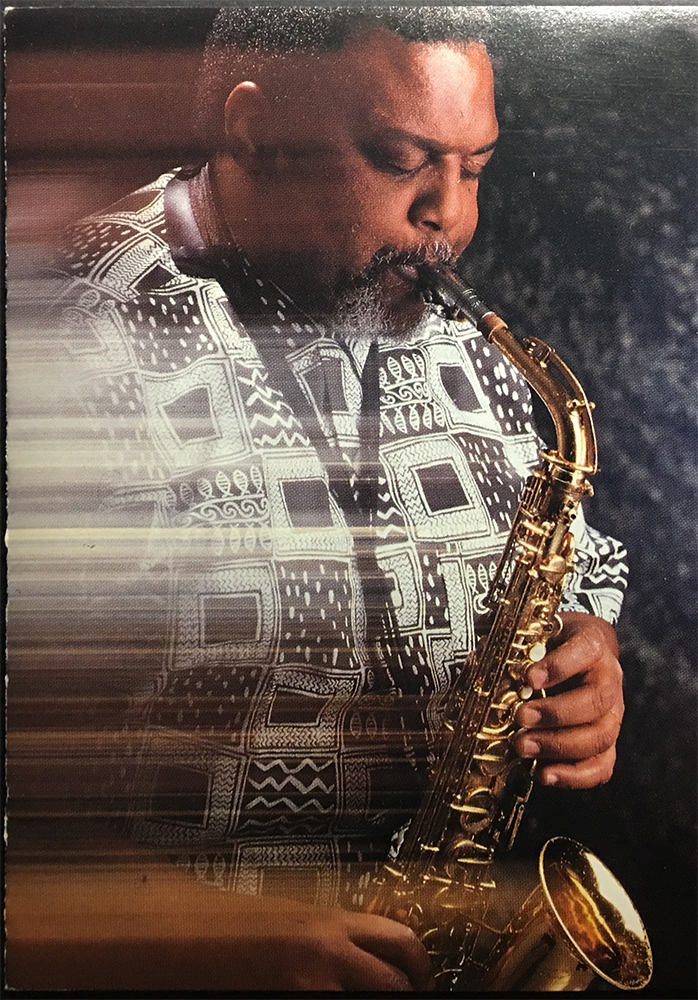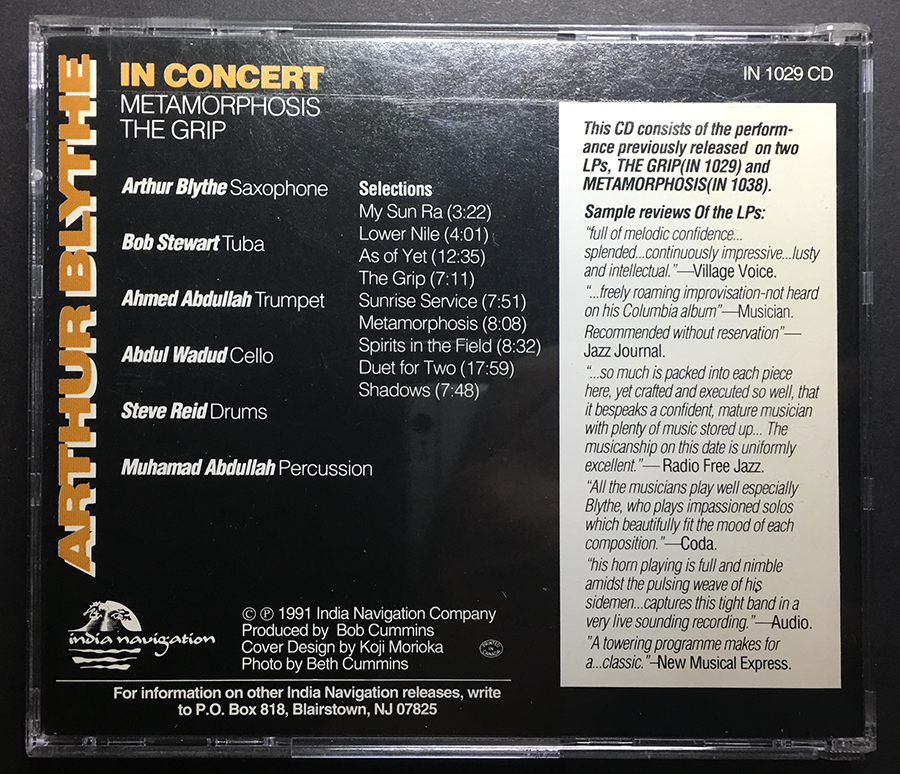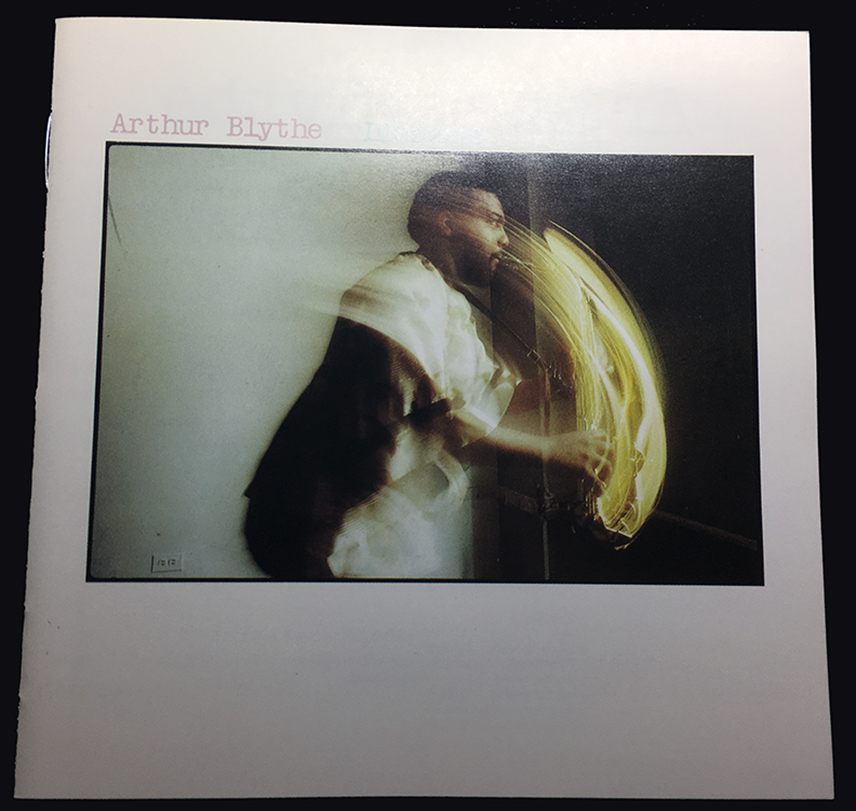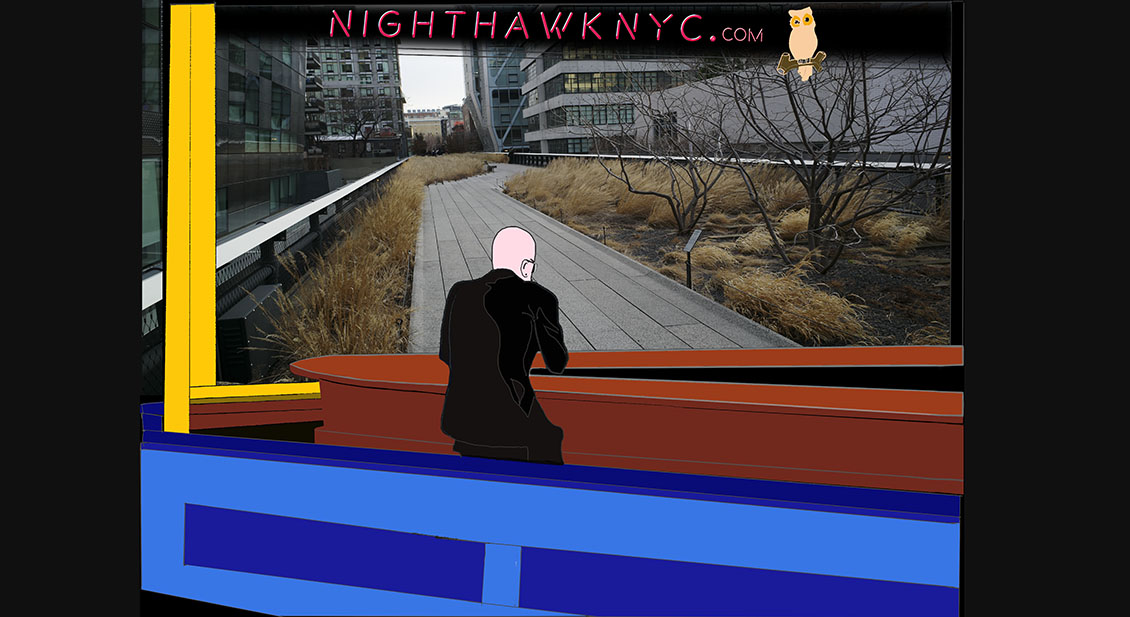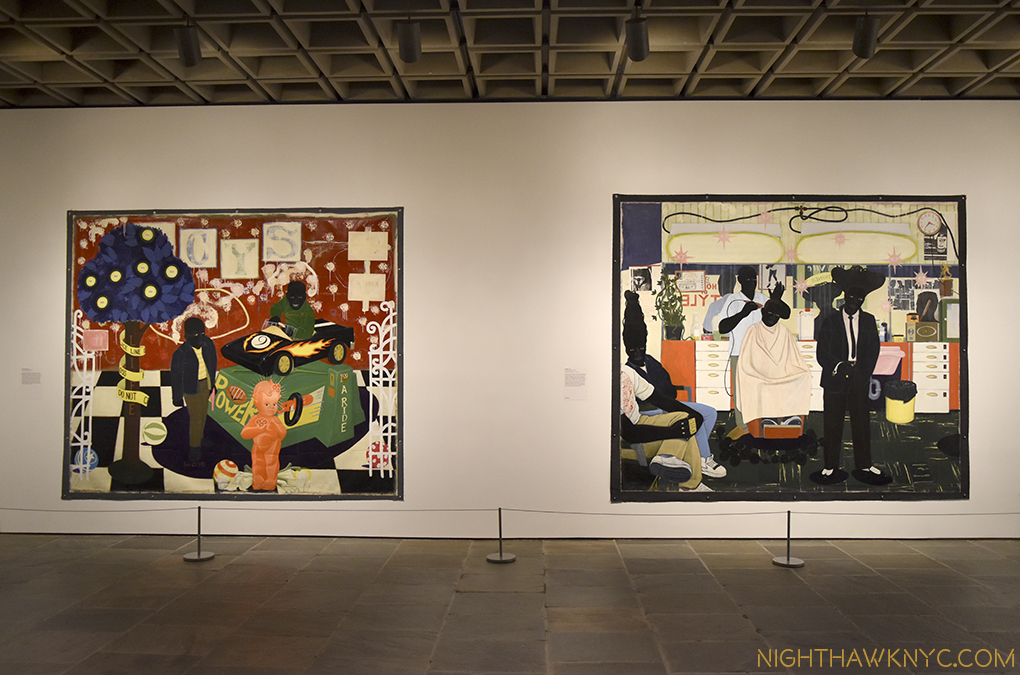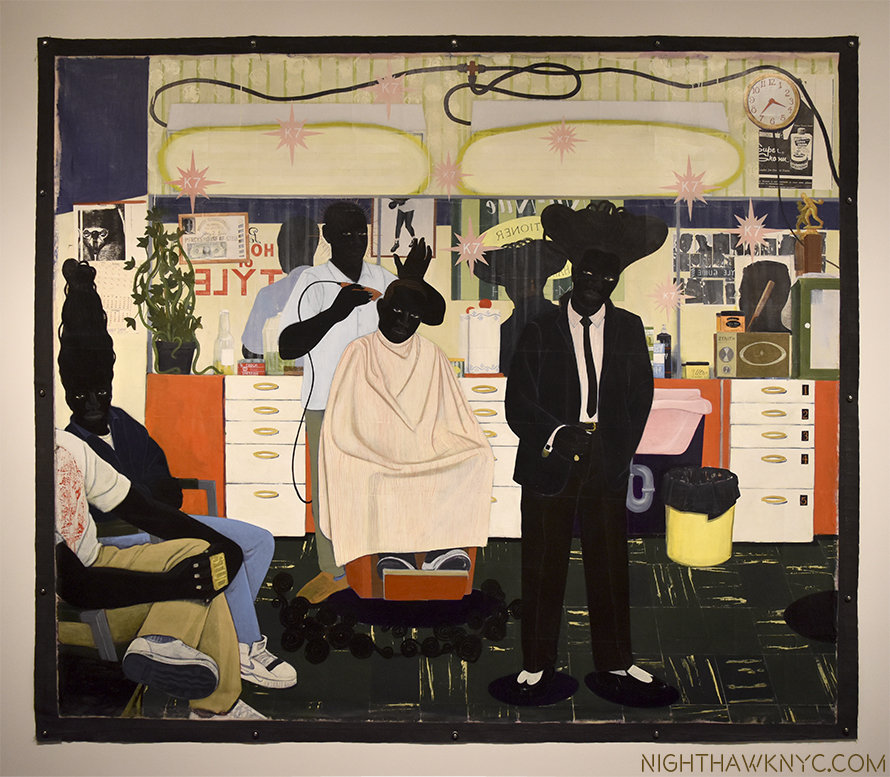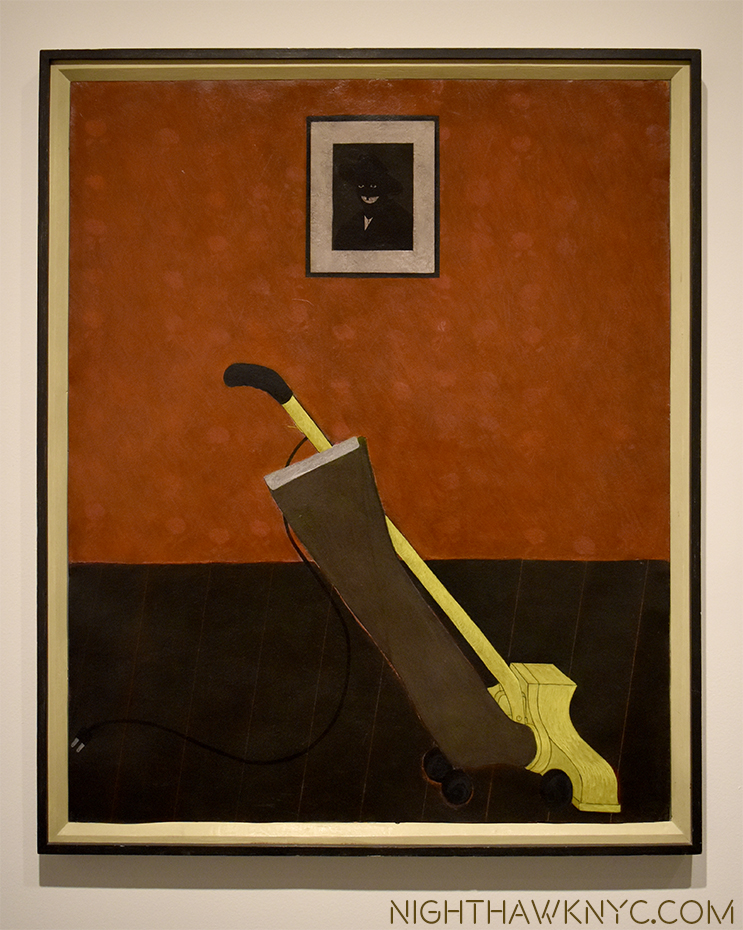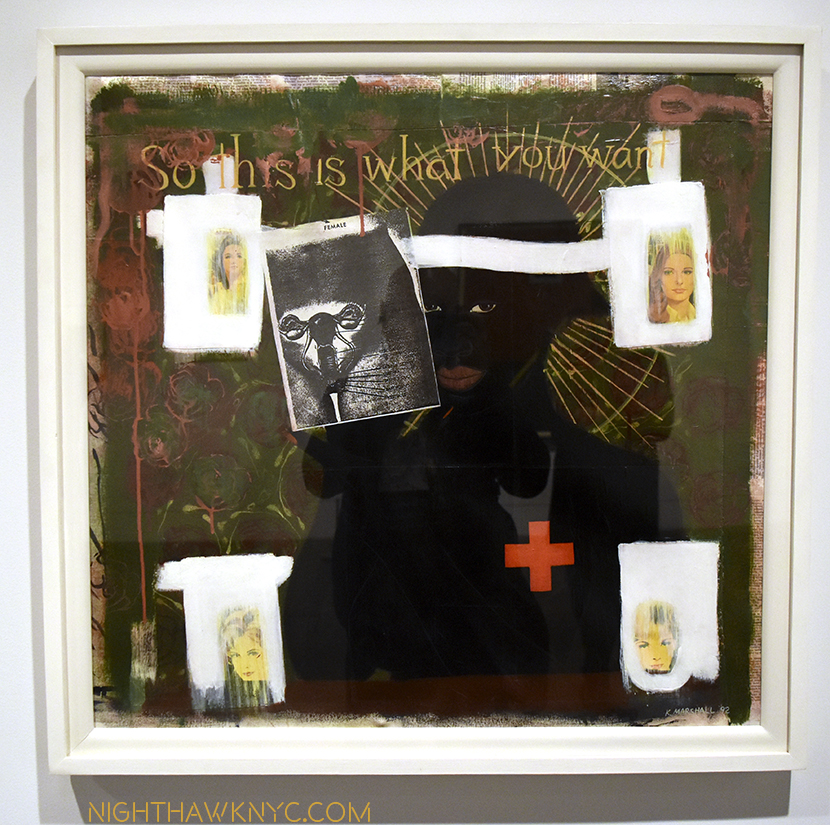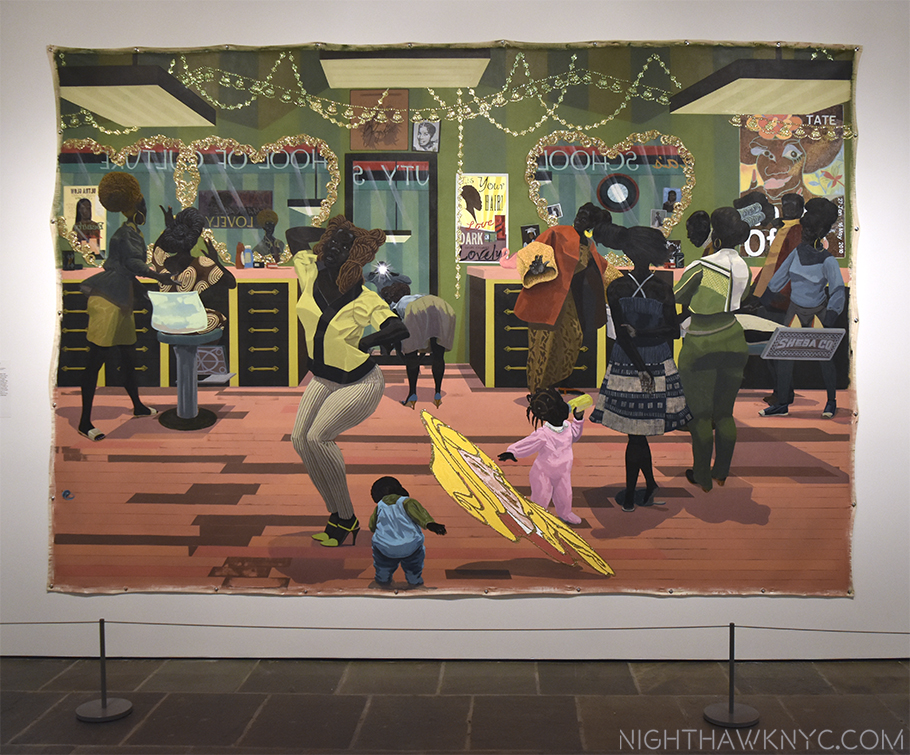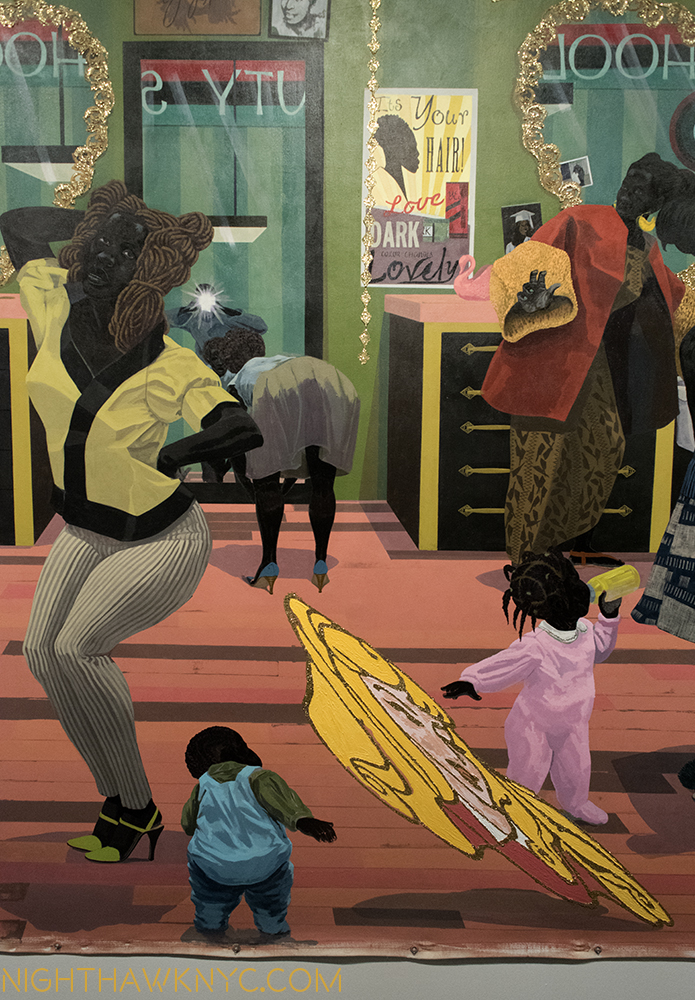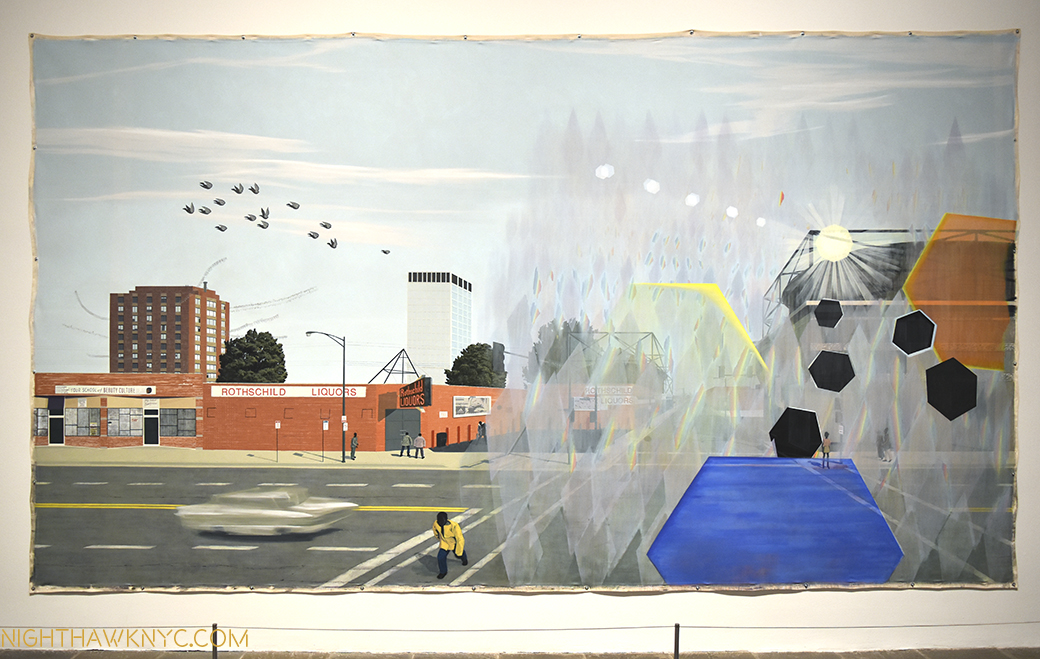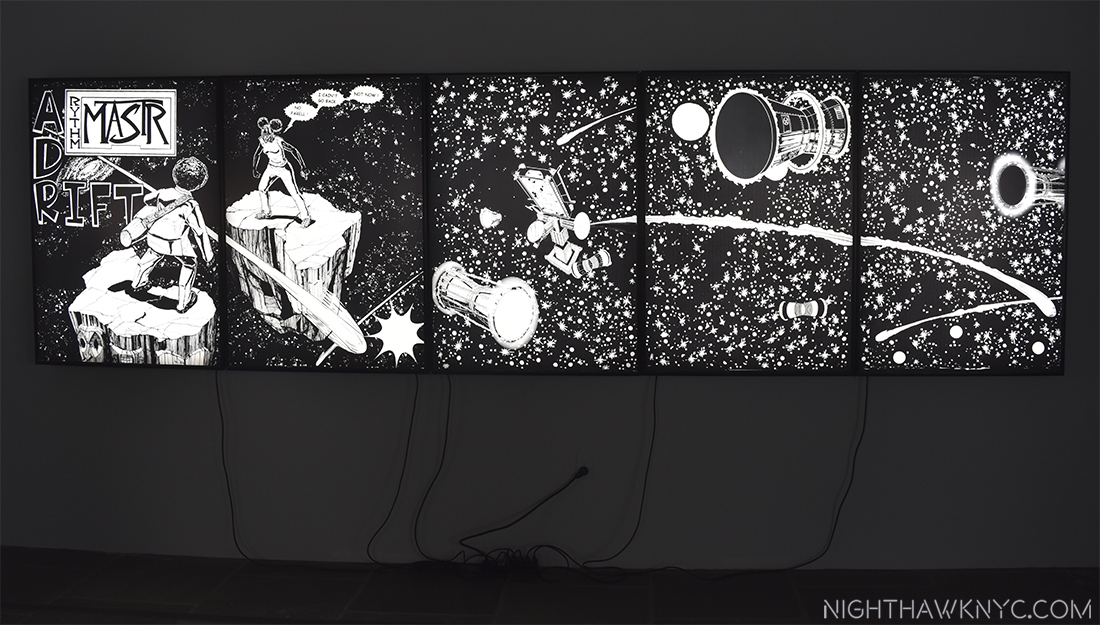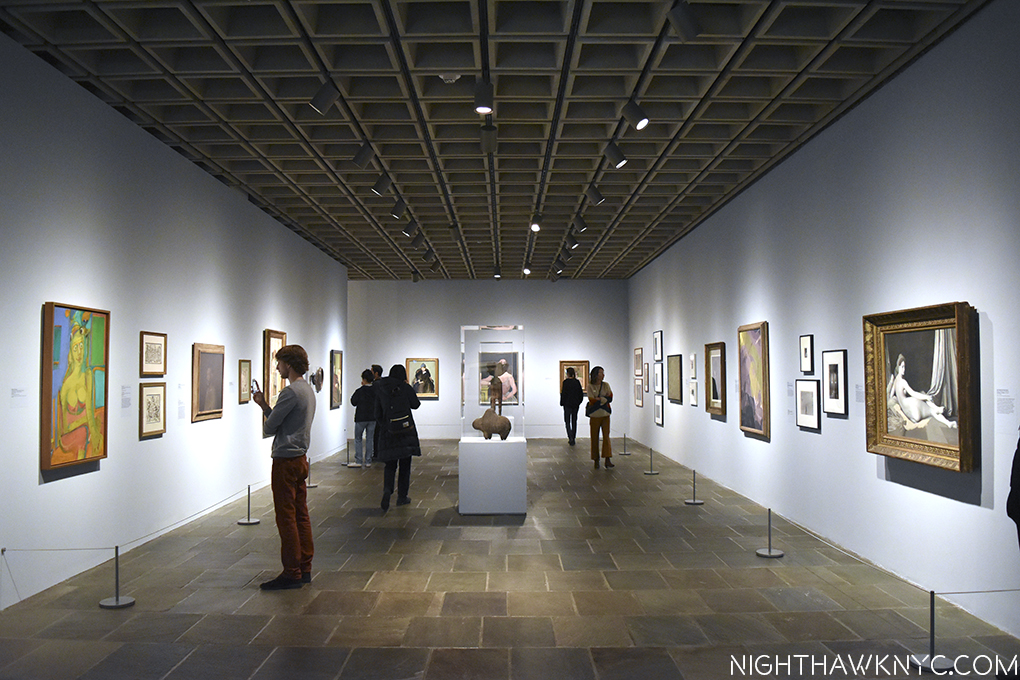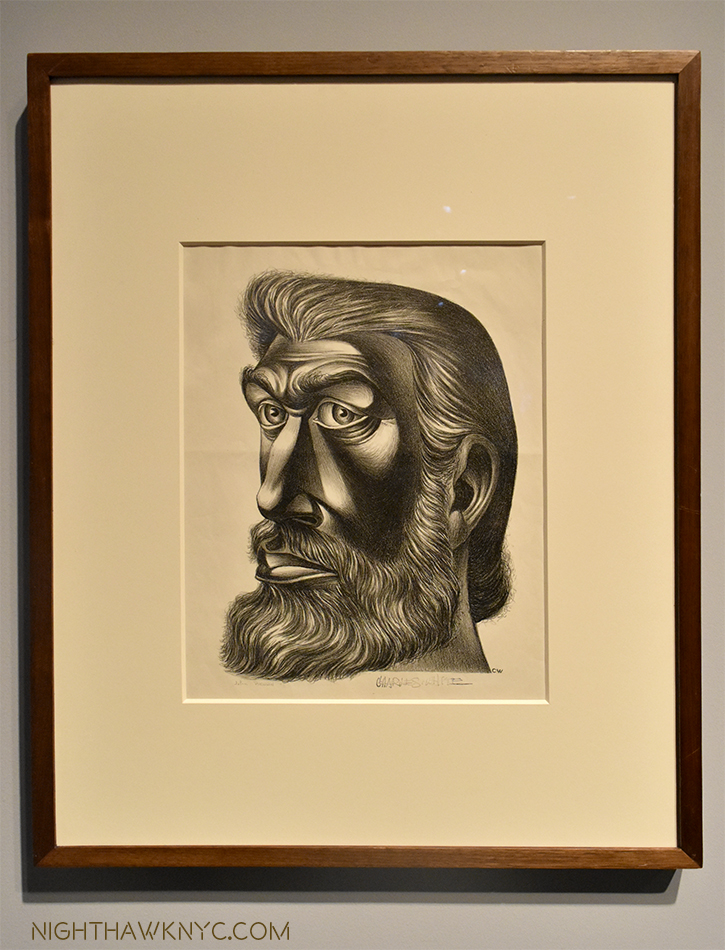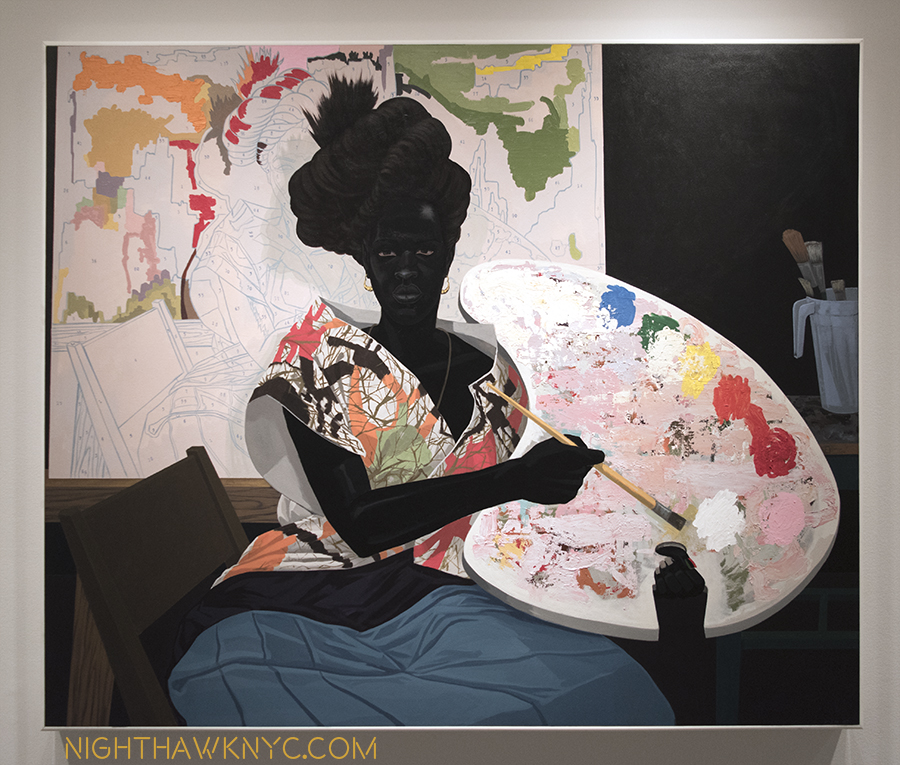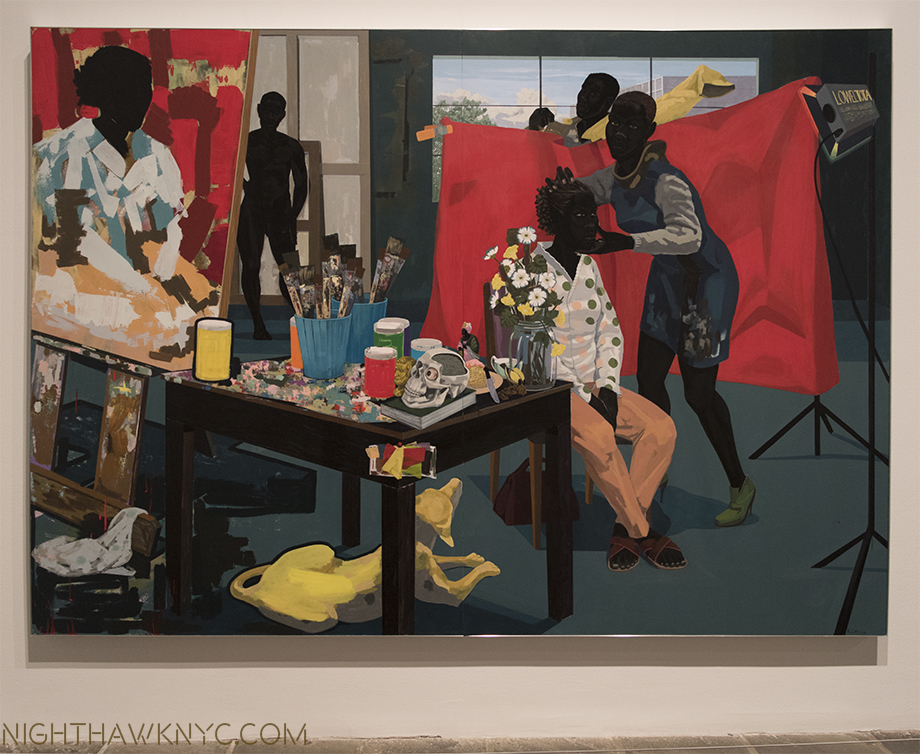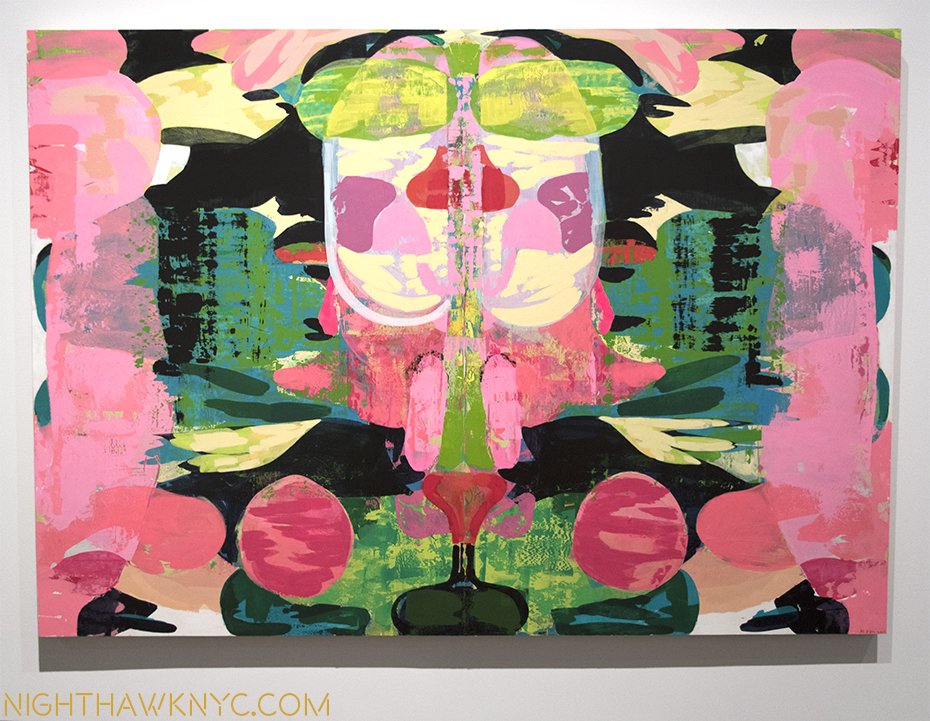This site is Free & Ad-Free! If you find this piece worthwhile, please donate via PayPal to support it & independent Art writing. You can also support it by buying Art & books! Details at the end. Thank you.
Written & Photographed by Kenn Sava (*- unless otherwise credited)
(This is, also, my NoteWorthy Show for January, 2017.)
I’ve been looking at R. Crumb for a very long time. At least 20 years. Of course, his work predates that by a further 35 years, and today I still find all of it compelling. Unfortunately, the chances to see a number of original works by R. Crumb remains all too rare. The chance to see the Artist himself, rarer still. So rare, I never have. I tried in vain to find out if he would be appearing at the opening for the show co-starring his wife of FORTY YEARS (in 2018), Aline Kominsky-Crumb, “Drawn Together,” on January 12, then decided to take a chance and swing by David Zwirner Gallery (most recently the scene of “William Eggleston- The Democratic Forest,” which pretty much turned my entire life upside down, launching my free-fall into a bottomless pit of research into Contemporary Photography. In fact, If I’m not careful, this will become a Photography Blog very soon!) and have a look see, anyway. I’m not one to attend Art Openings unless an Artist I’m interested in is making an appearance.
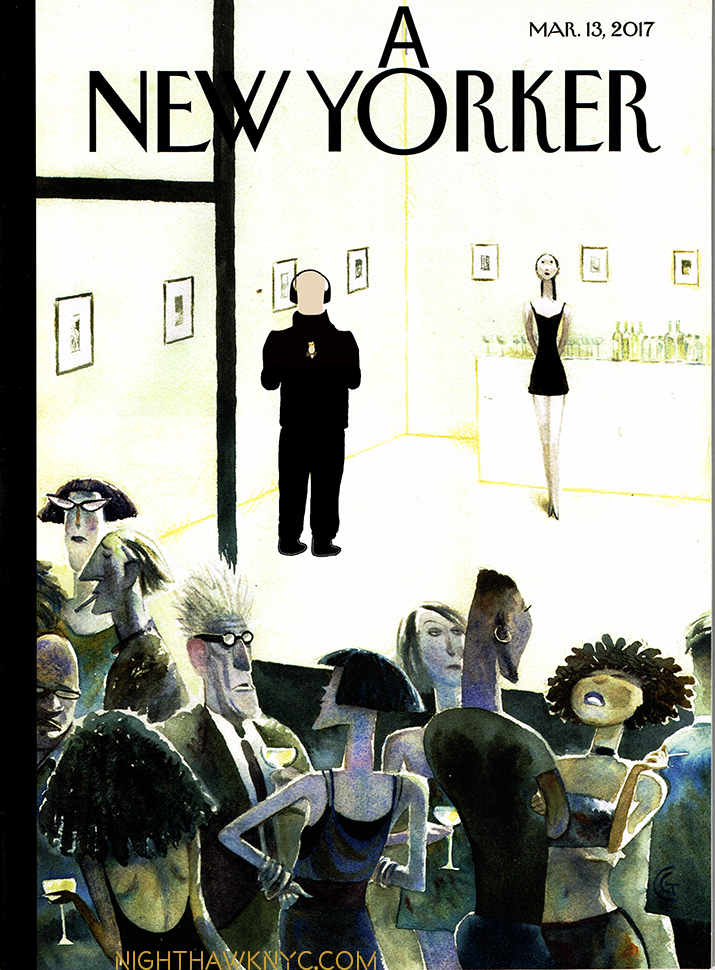
The Nighthawk At The Opening (Artist’s conception, cause I generally don’t attend them). Adapted from The New Yorker’s March 13, 2017 cover called “Opening Night.” I couldn’t resist. My Apologies to Artist Carter Goodrich, and the great editor Francoise Mouly (a friend of R. & Aline Crumb).
R. Crumb’s work occupies a unique place somewhere between what’s been traditionally the so-called “low-brow” world of comics and “Fine Art,” that’s been hard won. Bursting on the world’s awareness like a supernova in 1967, when he was there are the genesis (sorry) of what would come to be called “Underground Comics,” a genre of which he soon became the de-facto figurehead of, and, for many, it’s most important Artist. Over the years, his work has begun to be more fully appreciated beyond the world of Comics. The late Art Critic Robert Hughes called him “the Brueghel of our time.” Even that lofty observation barely scratches the surface of R. Crumb’s impact and influence. While I was walking the streets of Chelsea to the opening of this show, admittedly with Crumb on my mind, I found it quite hard not to see his influence in the work of a number of shows I passed by Artists who’s work has nothing to do with comics or graphic novels and even in the flared pants snd chunky shoes women seem fond of these days. While Crumb’s work remains under-appreciated by the Fine Art world, in my opinion, his influence has barely begun to be seriously considered.
Arriving, I walked in to a good sized crowd…and live music. As I made my way through the gallery to the rear, large room. Low and behold…
R. Crumb, himself.
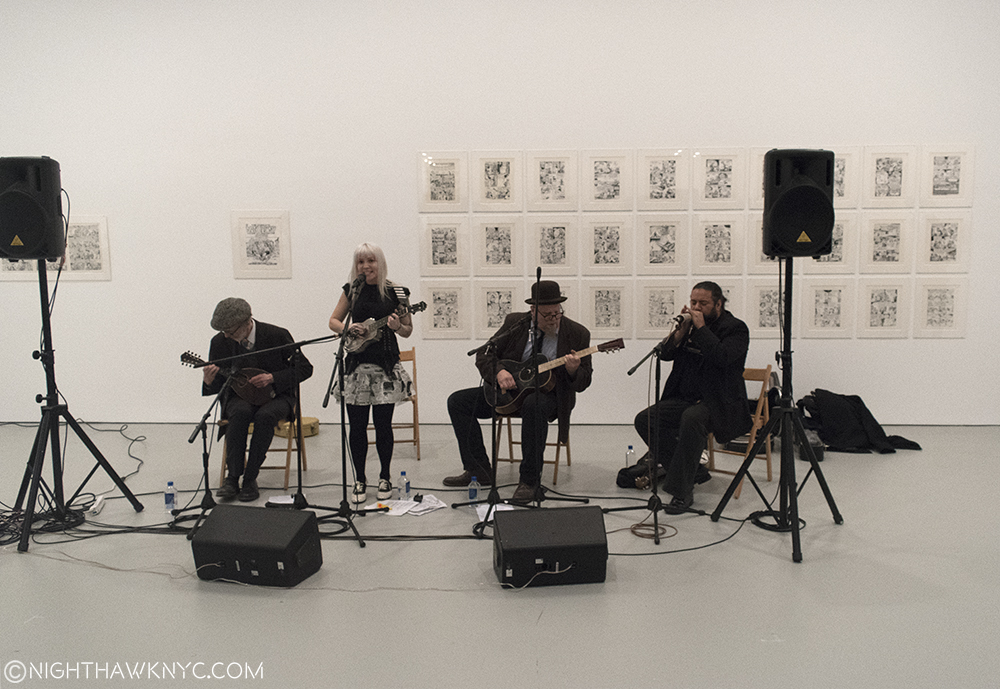
Art, and Artist. R. Crumb on left-handed mandolin(!), appropriately on the far left, performing with the East River String Band, at the Opening, David Zwirner Gallery, West 19th Street, January 12, 2017.
…looking just like a comic of R. Crumb, himself. He was seated wearing a cap and playing a mandolin with a group, the “East River String Band,” who’s blonde singer and one of the musicians I immediately recognized from covers R. has drawn for the band’s albums. The music was lively and pleasant, but, frankly, it went right past me. I couldn’t get over the fact that here he was, a few feet in front of me. Every little move he made fascinated me- he plays left handed!? (he writes & draws lefty, too), how he interacted with the other musicians (he seemed to mostly follow), how he held his instrument, how he sat while playing it (slightly folding himself around it)…Partly, the former Musician in me was interested. Mostly, it was because R. is someone who seems to do everything he does deliberately, so this might reveal some small key to the Artist.
The set ended, and I moved a bit closer as the equipment was torn down. R., his instrument put away, remained in his chair. Carefully approached by a few (the legend of his not being a fan of his fans well-known to his, um, fans), only one, who he appeared to know, actually dared speak to him. He presented a book. It may have been one they collaborated on.
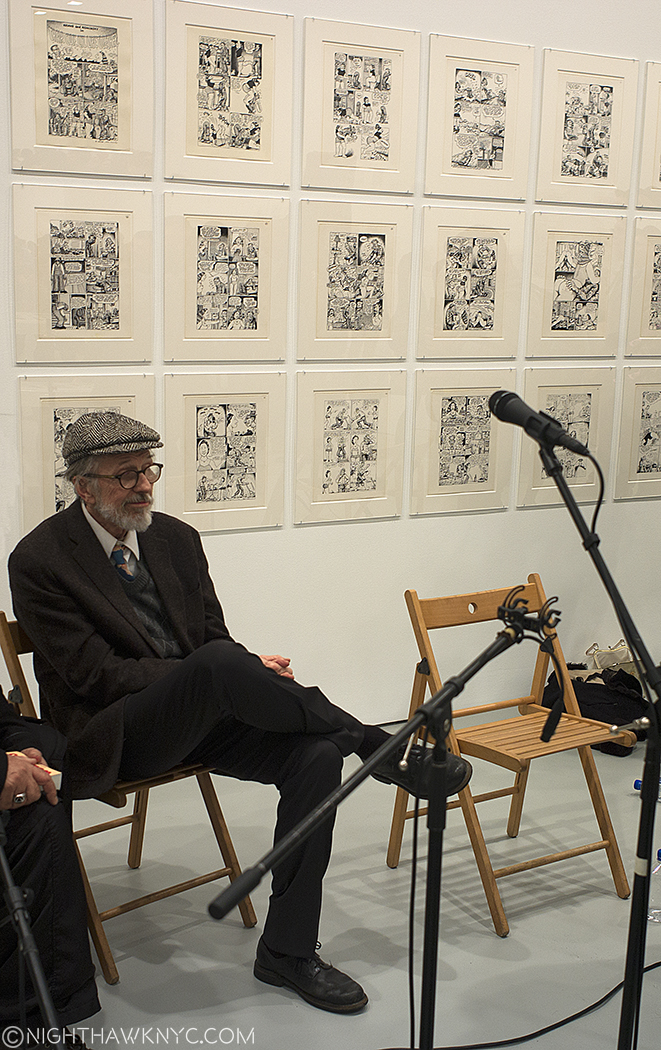
Alone in a crowd. R. Crumb after the set.
I watched the Artist reach into his inside jacket pocket and produce a white pen to sign it. I immediately recognized it as a Rapidograph pen, the pen he’s made famous, at least for me, because they are what he’s drawn with for lord knows how long now. I had never heard of them until I found out he used them a decade ago, and immediately bought a set for like 120 bucks. Then, I realized that drawing in ink is not for those squeamish at the site of their own blood. So? Back to graphite and my trusty eraser it was for me, leaving ink to Master Draughtsmen, like R. Crumb. To this day, It’s always funn to look at a Crumb original and see if there is any use of White Out Correction Fluid on it or not. He will do the most intricate cross hatching and there will be no White Out to be seen, anywhere. I don’t think I’ve drawn in ink since.
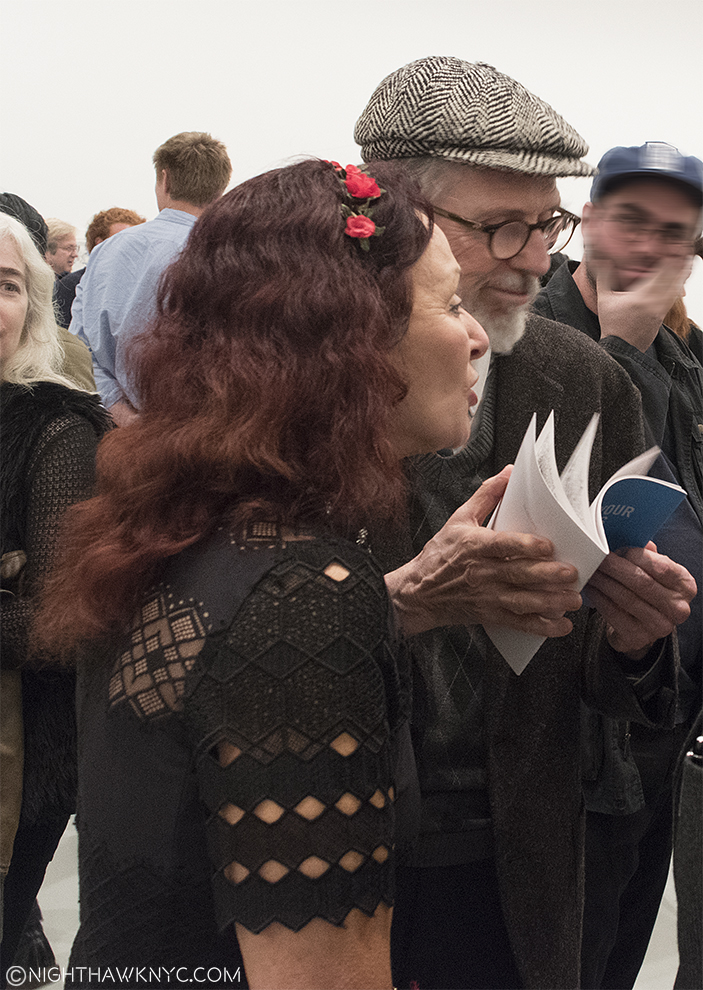
Happy Early 40th R. & Aline! HOW did you do it?? Maybe the gent in the back is wondering, too.
He looked a bit older than the last time I’d seen him on video, a bit frailer, perhaps, then he stood up, and with Aline alongside, made his way through the throng to the gallery’s offices, not to be seen again (at least while I was there). Due to the Opening Night crowd, I returned a number of other times to see the actual show.
What I saw was shocking.
As shocked as those at the opening may have been by the unannounced (as far as I know) appearance by the Artist, more may have been shocked by the excellence of the “other Artist” who shared the bill with R. Crumb, his wife of 40 years (next year. Sorry. I can’t stop saying that because it blows my mind), Aline Kominsky-Crumb.
Yes, excellence.
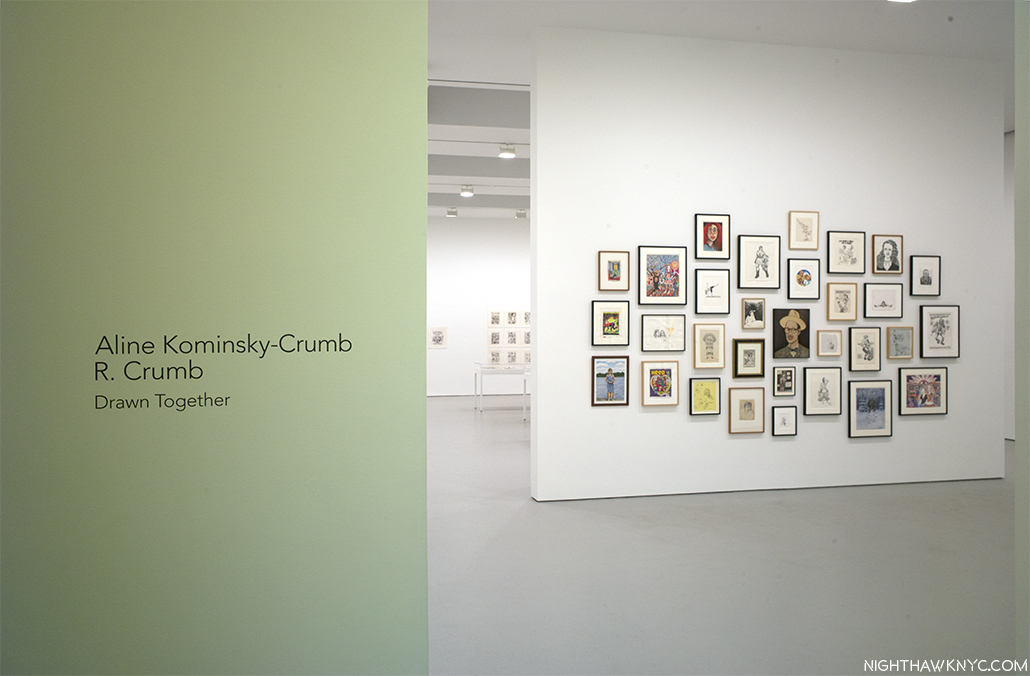
Anyone who can go toe to toe (not to mention parts more intimate, but no less appropriate to this show), with R. Crumb over the course of most of a show (and ALL those years of marriage) is someone who deserves an award. Well, at least recognition. It’s high time Aline Kominsky-Crumb be acknowledged, and accepted, and her considerable body of work be appreciated. “Drawn Together” made the case for that as well as it’s likely to be made.
The standard “knock” against her has to do with her draughtsmanship. Even she mentions it in a panel here. There are many cartoonists, graphic novelists, even Artists hanging in The Met, who’s draughtsmanship is “suspect,” (to be kind). It’s missing the point. The point of Art is to express and communicate, (even if the latter is “only” a byproduct). Those just happen to be Aline Kominsky-Crumb’s strongest suits.

But, yes, there are masterpieces by the Master of Underground Comics to be seen here, too. The ten page story, “Walkin’ The Streets,” wherein we witness a conversation between R. and his late brother, Charles, strikes me as one of his great(est) works.
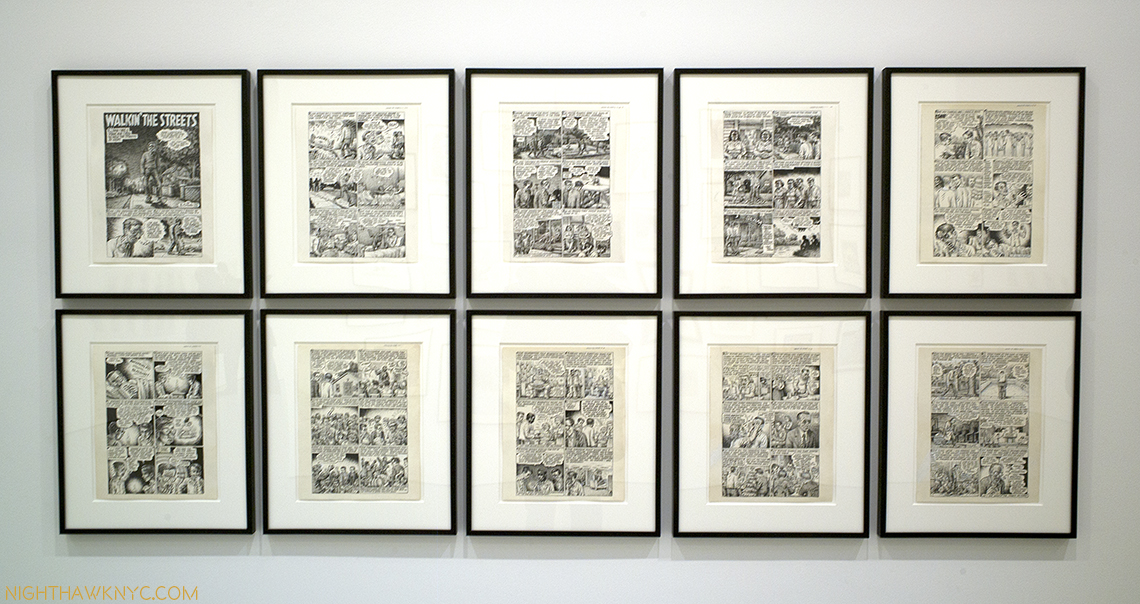
R. Crumb’s “Walking The Streets,” with his dear brother, Charles.
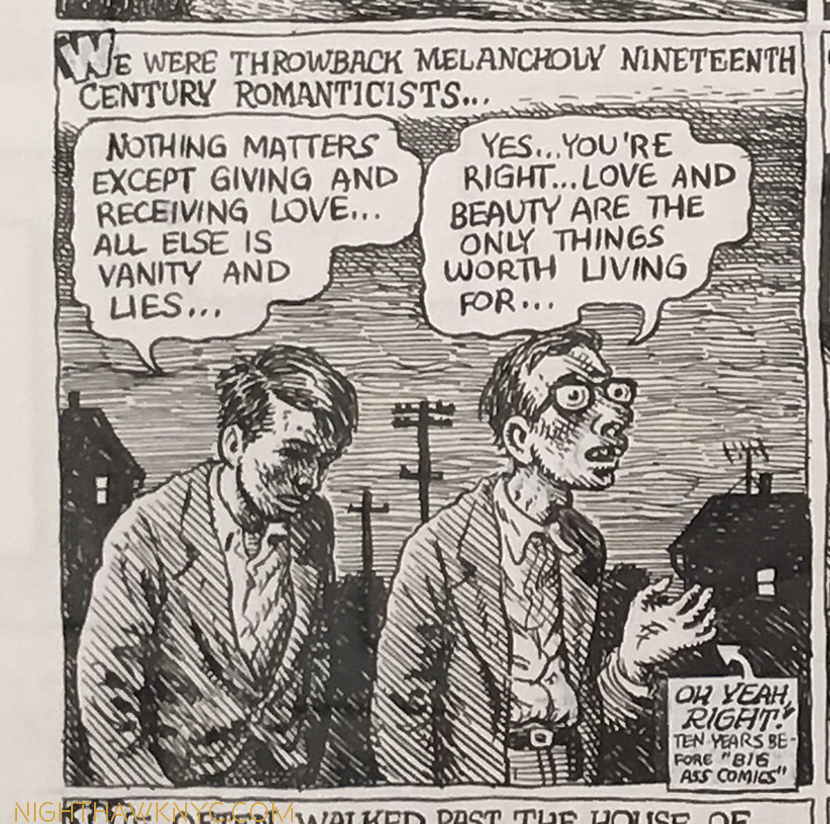
Charles(left)? I was just saying the same thing, here, a few weeks back.
In fact, on the subject of draughtsmanship, it’s actually arguable who among the three Crumb Brothers, was/is the greatest. R. has spoke glowingly of Charles’ talents. He passed at age 50 from an OD of his prescribed drugs.
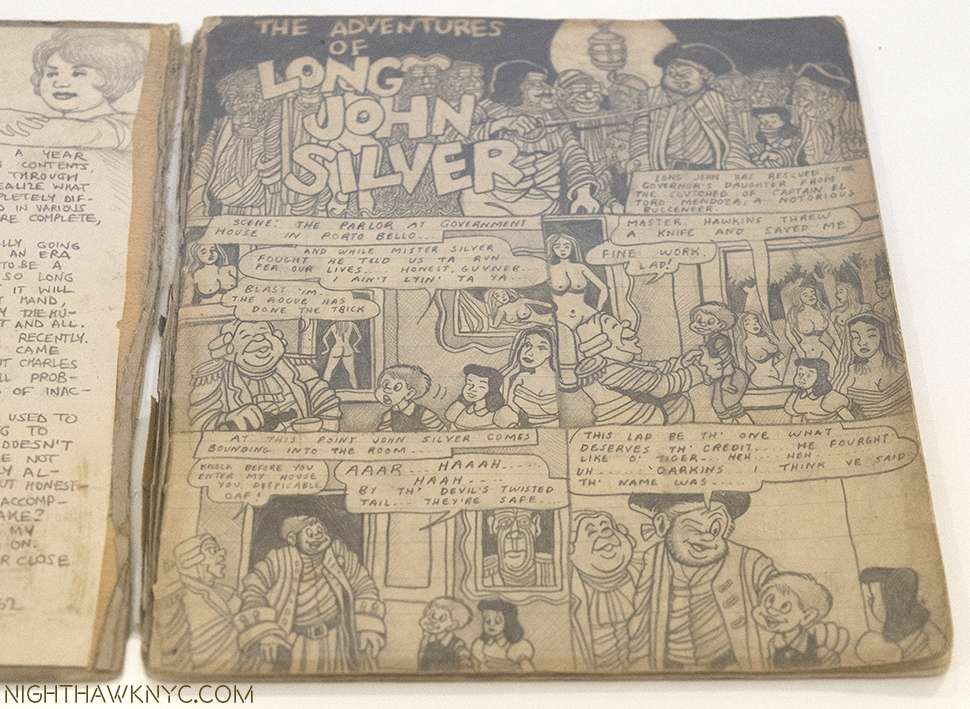
A page from an extremely rare surviving sketchbook by Charles Crumb reveals his obsession with “Long John Silver.” See Terry Zwigoff’s superb documentary “Crumb” for more, and seldom seen video of Charles and Maxon.
The other brother, Maxon’s, work is ingeniously intricate, and brilliantly executed, though both of those are matched by his penchance for obfuscation and symbolism. If you can fight through that, you will find an Artist who doesn’t fit into the “comic book,” or even graphic novel genre, but an Artist, who’s path is closer to that of a Fine Artist. While R.’s originals sell for up to six figures (before the decimal point), Maxon’s drawings sell for hundreds, maybe a thousand dollars, his scarcer paintings for maybe 10 to 15 grand. In my opinion, he is very unfairly overlooked, (a bit like Charles Pollock is to his brother, Jackson Pollock.) Look at this-
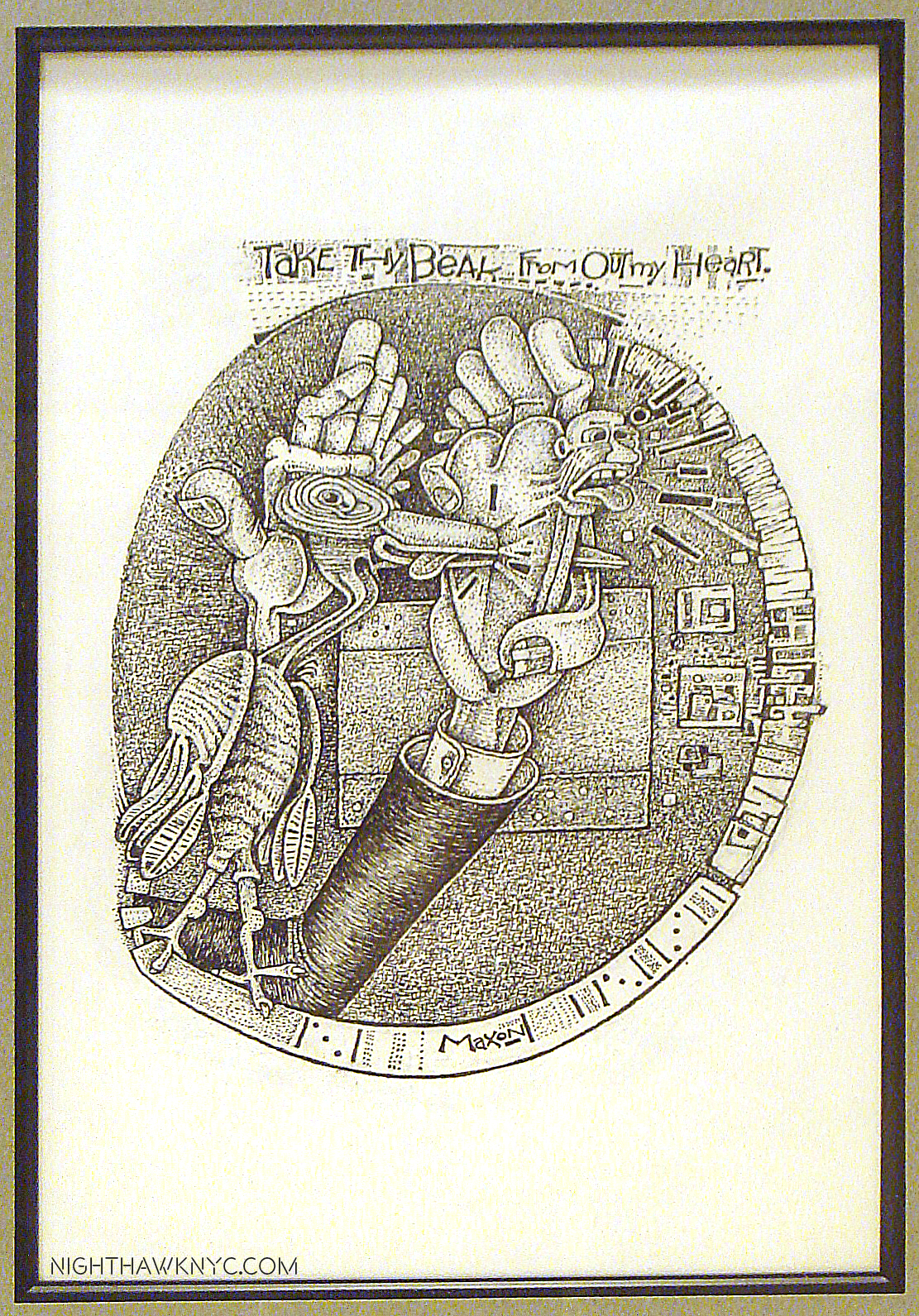
Maxon Crumb’s “Take Thy Beak From Out My Heart,” Ink. The intricacy of this work is just staggering. (This was not in the show).
Speaking of being overlooked, R. Crumb has been ever so gradually finding acceptance as a Fine Artist on his way to being recognized as a “great Artist.” Beyond his draftsmanship, the honesty in his work is something that might seem common now, in this age of so-called “reality” shows. R. Crumb is the original reality star in the sense of honesty depicting himself- “good,” and “bad.” This turned off many, and it, too, hasn’t “mellowed” much over time. Though things like his sexual preferences (and appetites) remain controversial, and retain the ability to shock, as does how nakedly he discusses his inner feelings and thoughts. His wife is no shrinking violet, either. She never hides what she’s thinking or feeling, about herself, or anyone else, either. As a result, she is, perhaps, the ideal collaborator and foil for R..
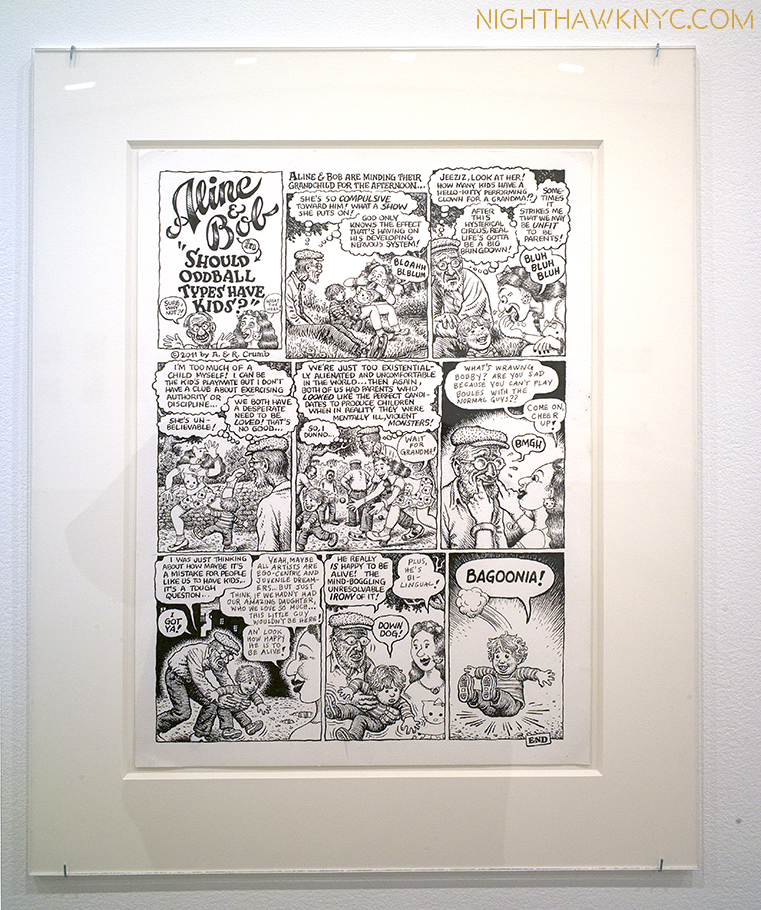
R. & Aline Crumb, “Should Oddball Types…,” ink. Just one example.
The results present countless fascinating insights into their lives and their long standing open marriage. Making it a family affair, daughter Sophie, now an adult Artist with children of her own, makes an appearance, too. Want to hear what the Crumbs think about having kids? How Aline knows that R. hasn’t left her? (Hint- It has to do with vinyl.) How much R.’s “Book of Genesis” was sold for by Zwirner? How sobriety has been going for Aline? The joys of owning a “vintage” refrigerator,” or, you just want to watch R & A get “50 Shades”-style kinky? It’s all here. In fact, what’s here, and unspoken, is that the two of them have quietly amassed a major body of work. Appearing, variously, under titles including “Self-Loathing Comics,” or “Dirty Laundry Comics” (what could be more appropriate?) it’s now, finally, collected in the 184 page catalog for the Cartoonmuseum Basel version of this show, entitled “Drawn Together.”
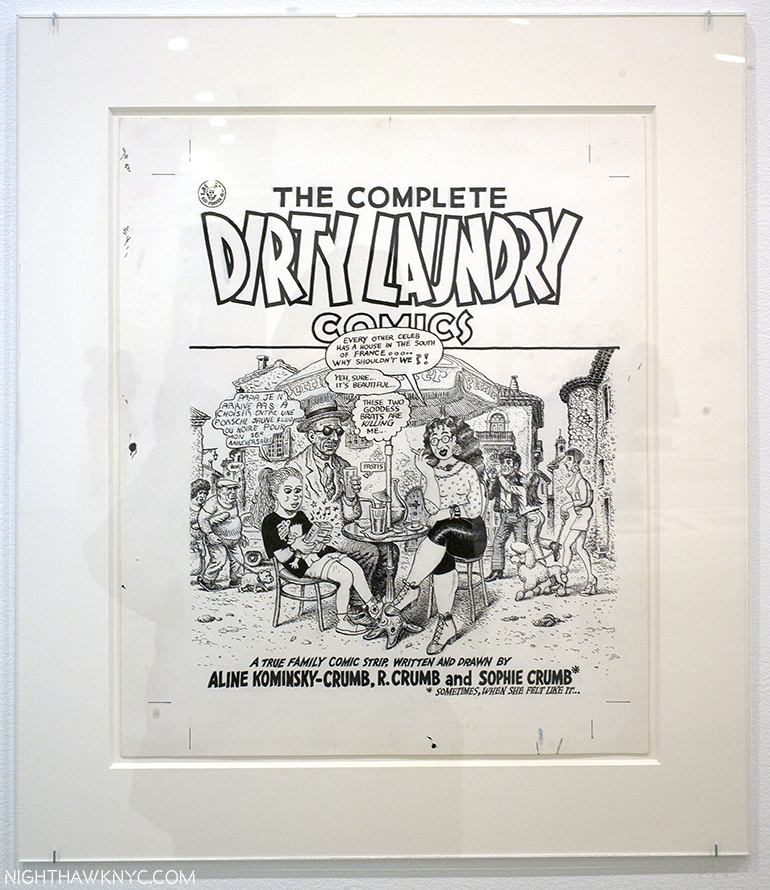
R., Aline & Sophie Crumb, “Dirty Laundry” Cover Art, Ink.
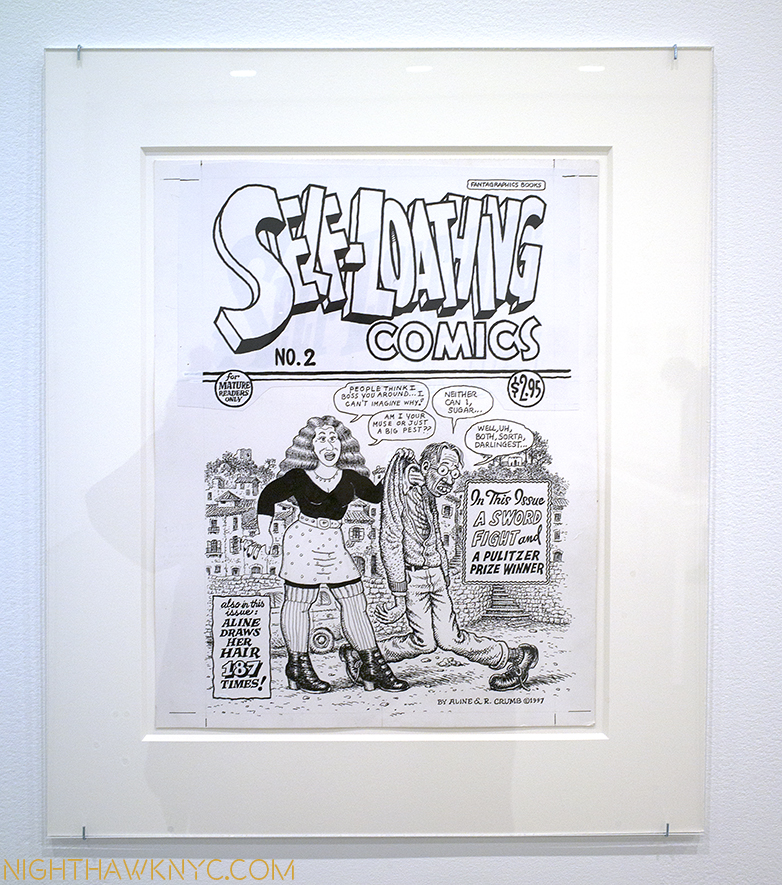
R. & Aline Crumb, “Self-Loathing Comics,” Cover. Ink. After the age of “superheroes,” R. ushered in the “reality” based Artist as anti-hero age, we’re still in the midst of. And, Aline will keep drawing her hair to prove it!
Highlights? For me? Aline’s “My Very Own Dream House,” which takes up almost the entire front gallery, and holds rapt attention over 33 pages.
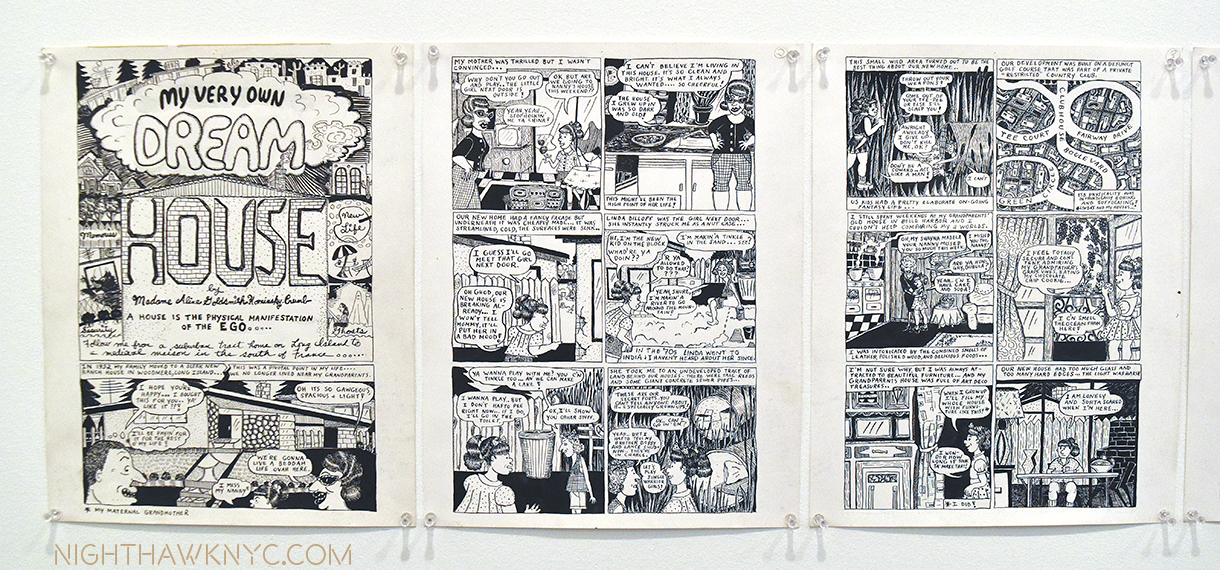
Aline Kominsky-Crumb’s “My Own Dream House,” Ink, beginning.
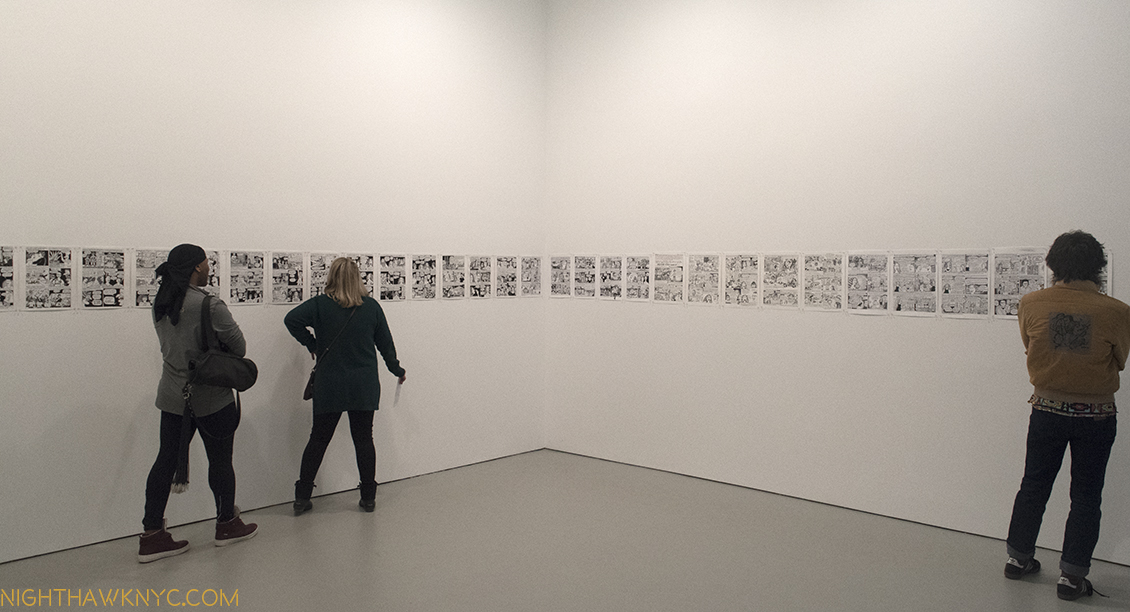
Installation view of (almost) all of it.
Her “Goldie in Fanatic Female Frustration” in the main room, in a different drawing style, is sparser, but none the less engrossing.
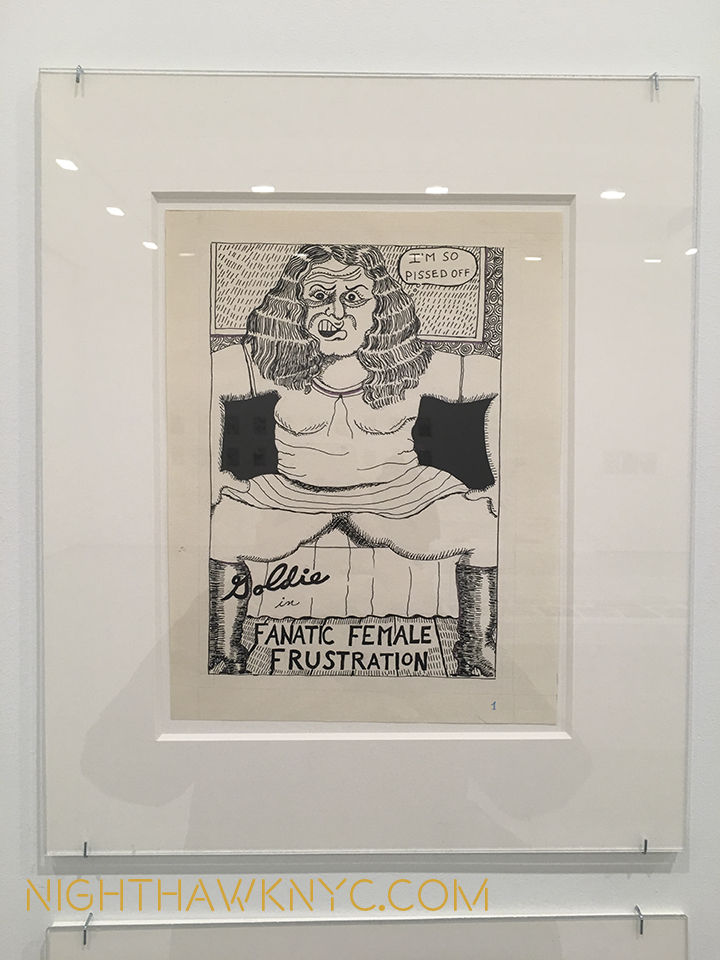
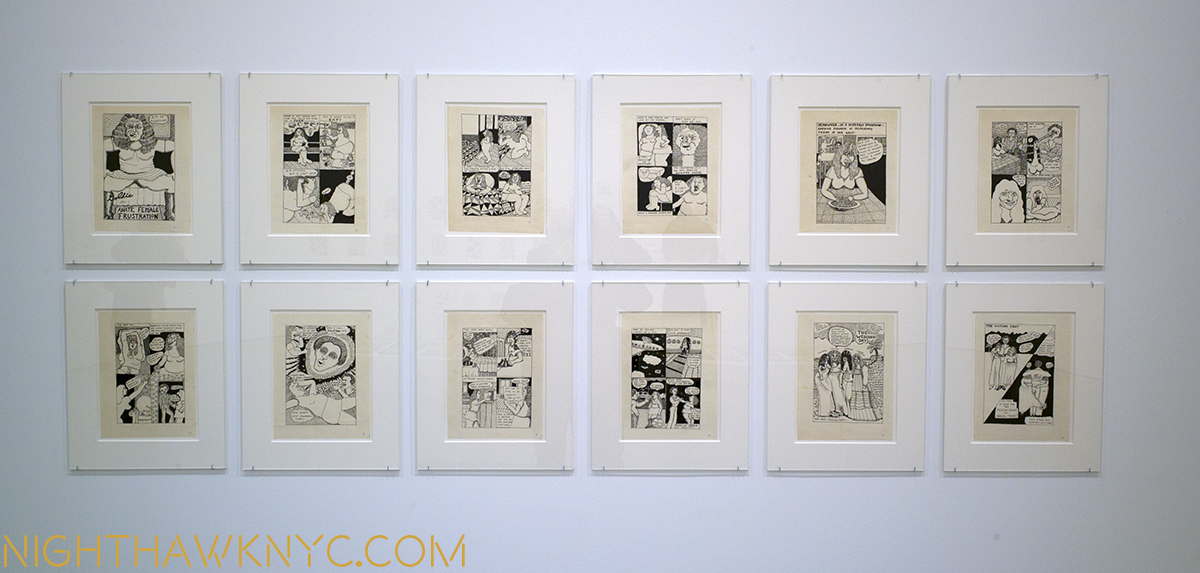
Aline Kominsky-Crumb’s “Goldie,” ink. Even at a distance, the unique style of this terrific work grabs you, and perfectly conveys the fanatic frustration within.
Along with these, we get a case of R.’s classic underground comics, ranging from “Zap” #0 to “Fritz The Cat” to “Weirdo,” a case of early drawings and sketchbooks, including the very rare sketchbook of Charles’ shown above, and a collection of family photos.
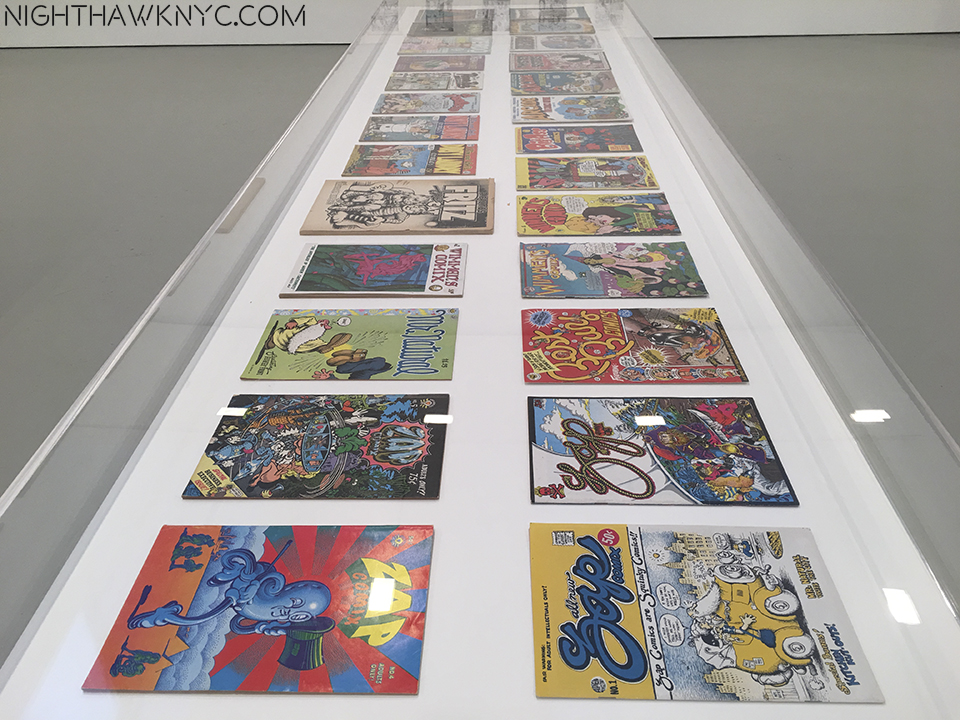
A Hall of Fame of Underground Comic Classics.
If Aline was the star of this show, if not a revelation for me, R.’s star now shines all over the world, as we see in their collaboration about their visit to Belgrade, where they were treated like “superstars,” Aline writes. At Zwirner, the range of folks coming in to see this show was striking. It was, literally, every kind of person imaginable. Young, old, male, female, black, white, hipster, hippie, businessman, writers, photographers and yes, Artists.
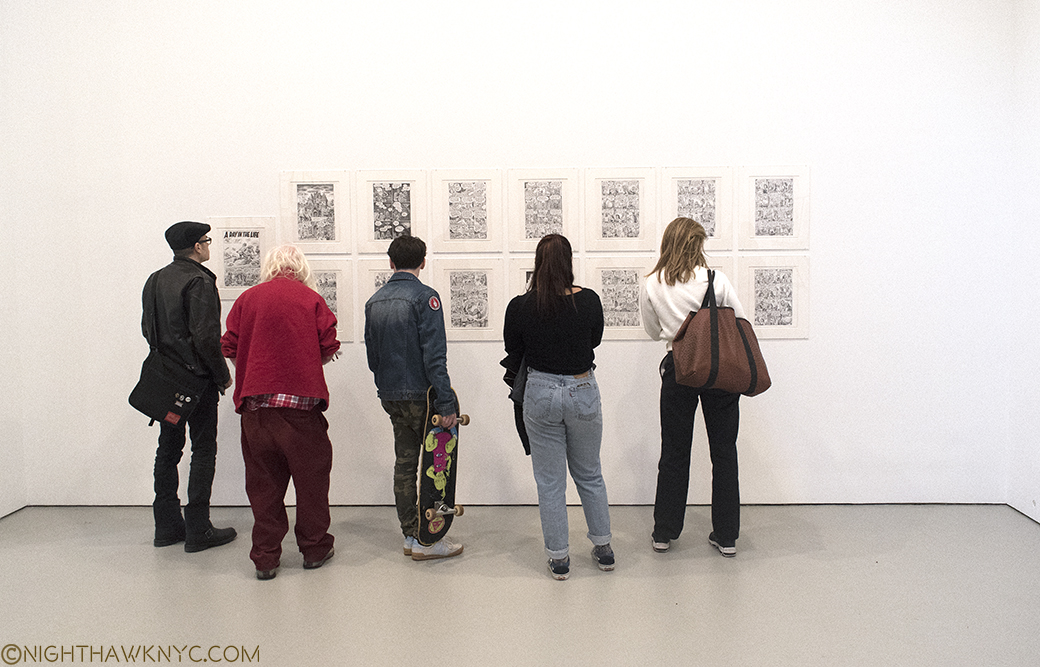
One thing that surprised me was how many of them took the time to read the works. It’s one thing to read a comic book or graphic novel in a book, it’s another to read a 10 or 20 page story hanging on a wall, especially when half of it is hung higher than eye level. Yet, I watched person after person read each panel before moving a foot to their right to read the next. Since comic Art or Graphic Novels aren’t often seen in galleries or museums, I found this an unusual, interesting and refreshing thing. Most people seem to spend 1/4 the amount of time in front of paintings.
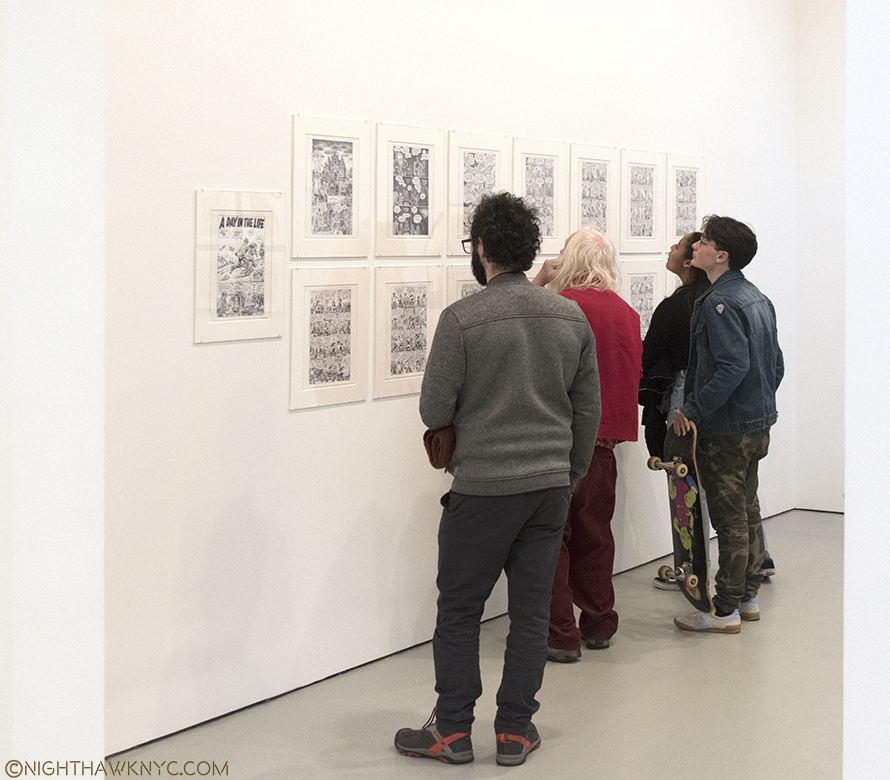
Crumb shows are way too infrequent. The last NYC show, “The Book of Genesis,” was also at Zwirner in 2010! While I expect, and welcome, future Crumb gallery shows, the time has come for a Crumb show in an NYC Museum.
Any bets on who will be the first to step up? My guess is MoMA. I think it’s a matter of when, not if. It’s hard to imagine it not being a blockbuster show.
It would be nice if it happened while he’s still around to see it. That is, IF he decides to actually show up to see it.
*- Soundtrack for this Post is “Ball and Chain,” as recorded by Janis Joplin and Big Brother & The Holding Company (what else?), as recorded on “Cheap Thrills,” 1968(! FIFTY years ago next August), with an R. Crumb cover, one of the most classic album covers ever done, which might have made him as famous as anything else, and written by Big Mama Thornton.
NighthawkNYC.com has been entirely self-funded & ad-free for over 8 years, during which 300 full length pieces have been published! If you’ve found it worthwhile, PLEASE donate to allow me to continue below. Thank you, Kenn.
You can also support it by buying Art, Art & Photography books, and Music from my collection! Art & Books may be found here. Music here and here.
Written & photographed by Kenn Sava for nighthawknyc.com unless otherwise credited. To send comments, thoughts, feedback or propositions click here. Click the white box on the upper right for the archives or to search them. Subscribe to be notified of new Posts below. Your information will be used for no other purpose.
